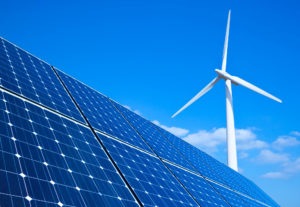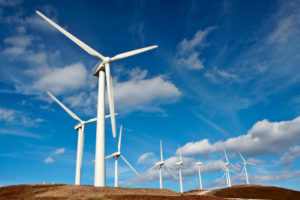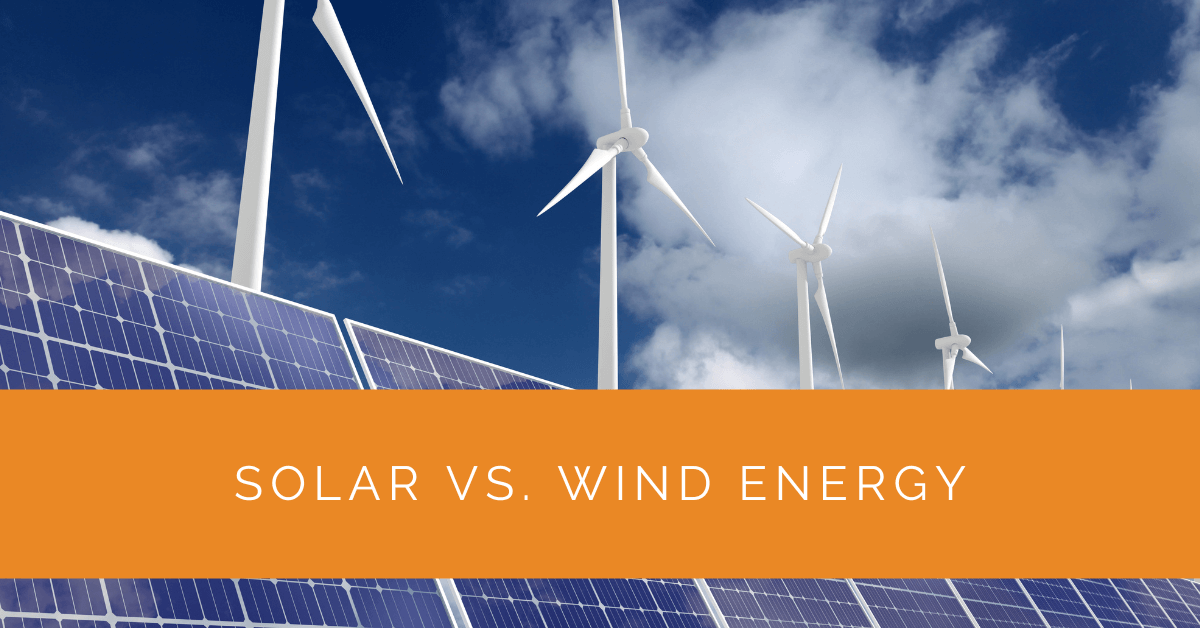In today’s rapidly evolving world, the transition to renewable energy sources has become imperative, driven by the pressing need to combat climate change and reduce our reliance on finite fossil fuels. Two prominent contenders of renewable energy are solar energy and wind energy. Both have made substantial progress in recent years, contributing significantly to the global shift towards clean, sustainable power. This article delves deep into solar and wind energy, comparing their advantages, disadvantages, and applications to empower you to make a well-informed decision.
Contents
- 1 Key Takeaways
- 2 Harnessing the Power of the Sun: Solar Energy
- 3 Capturing the Breezy Potential: Wind Energy
- 4 Pros and Cons of Solar and Wind Energy
- 5 Solar vs. Wind: Key Considerations
- 6 Sustainable Energy Synergy: Combining Solar and Wind
- 7 Case Study: Implementing a Hybrid Solar and Wind Energy System
- 8 Expert Insights From Our Solar Panel Installers About Solar vs. Wind Energy
- 9 Experience Solar Excellence with Us!
- 10 Conclusion
- 11 FAQ
Key Takeaways
- Solar energy offers consistency and accessibility, making it a reliable choice for many regions. Wind energy, on the other hand, capitalizes on strong winds and can complement solar power in hybrid systems.
- When choosing between solar and wind energy, your geographic location and climate are crucial factors. Evaluate your area’s suitability for each renewable source.
- Combining solar panels and wind turbines in a hybrid system can maximize clean energy generation, providing a reliable and sustainable energy solution for your needs.
Harnessing the Power of the Sun: Solar Energy
The Solar Panel Revolution
Solar energy, a radiant and renewable power source, has revolutionized how we generate electricity. At the heart of this transformation are solar panels, sophisticated photovoltaic devices that convert sunlight into electrical energy. Let’s explore the myriad facets of solar energy:
Solar Panel Efficiency
One of the remarkable aspects of modern solar panels is their impressive efficiency. Innovations in solar cell technology have significantly improved the conversion rate of sunlight into electricity. Today, solar panels can capture and utilize sunlight with remarkable precision, maximizing energy production.
Environmental Impact
Perhaps one of the most compelling features of solar energy is its minimal environmental footprint during operation. Unlike fossil fuel-based power generation, solar panels produce no greenhouse gas emissions or harmful pollutants. This makes them crucial in reducing our carbon footprint and mitigating climate change.
Cost-Effectiveness
Over the years, the cost of solar panels has experienced a notable decline, largely driven by technological advancements and increased production scale. As a result, solar power has become increasingly affordable for residential and commercial applications. The prospect of reducing electricity bills and achieving long-term cost savings has made solar energy an attractive choice for many.
Exploring Solar Farms
Large-scale installations known as solar farms have proliferated worldwide to harness the full potential of solar energy. These expansive arrays of solar panels collectively generate substantial amounts of electricity. Solar farms are particularly advantageous in regions with abundant sunlight, such as arid deserts and sunny plains.

Capturing the Breezy Potential: Wind Energy
The Wind Turbine Phenomenon
Wind energy, another formidable contender in the renewable energy arena, relies on the kinetic energy of moving air to generate power. The iconic symbols of wind energy are the towering wind turbines that grace our landscapes. Here, we delve deeper into the world of wind energy:
Wind Power Efficiency
Wind turbines have also undergone significant technological advancements, improving energy generation efficiency. The modern wind turbine efficiently converts the wind’s kinetic energy into electrical power. These turbines come in various sizes, from small residential units to colossal structures found in wind farms.
Environmental Considerations
While wind energy itself is clean and sustainable, it’s essential to consider the entire lifecycle of wind turbines. The production, transportation, and eventual disposal of turbine components can have environmental consequences. However, these impacts are typically outweighed by the benefits of carbon-free energy production during a turbine’s operational lifespan.
Geographic Suitability
Wind power generation is highly dependent on wind speed and consistency. Therefore, location plays a pivotal role in the feasibility of wind energy projects. Coastal regions, open plains, and other wind-rich areas are more suitable for wind farm installations, where turbines can capitalize on consistent wind patterns.
Wind Farms: A Testament to Clean Energy
Wind farms, characterized by rows of majestic wind turbines, are a testament to the potential of clean and renewable energy. These large-scale installations are strategically positioned in regions with consistent and robust wind patterns to maximize energy output. Wind farms play a vital role in diversifying our energy portfolio and reducing our reliance on fossil fuels.

Pros and Cons of Solar and Wind Energy
Considering the advantages and disadvantages of solar and wind energy is crucial when deciding about renewable energy sources. Here’s a tabular representation of the pros and cons associated with these clean energy options:
Solar Energy
Pros:
- Abundant sunlight in many regions
- Minimal environmental impact
- Lower installation costs
- Reliability during the day
- Long-term cost savings
Cons:
- Energy production relies on sunlight availability
- Limited efficiency during cloudy or nighttime conditions
- Initial costs for solar panel installation can be high
- Efficiency varies depending on the location
- Dependency on weather conditions
Wind Energy
Pros:
- Suitable for wind-rich areas
- Clean energy source, no emissions
- Efficient at high wind speeds
- Complements solar for night-time energy
- Can generate large amounts of energy
Cons:
- Inconsistent energy generation depending on wind patterns
- Geographic limitations, not suitable for all regions
- Turbine maintenance and environmental concerns
- Possible noise and visual impact near wind turbines
Remember that the suitability of solar or wind energy depends on your location, climate, and energy needs. Evaluating these factors alongside the pros and cons will help you choose your clean energy solution.

Solar vs. Wind: Key Considerations
As you contemplate the choice between solar and wind energy, several key considerations should inform your decision-making process:
Location and Climate
Your geographic location and local climate are critical factors when choosing between solar and wind energy. Areas with ample sunlight are more conducive to solar power, while windier regions are better suited for wind energy generation.
Energy Production Reliability
Solar energy provides consistent electricity generation during daylight hours, making it a reliable power source. In contrast, wind speeds and patterns influence wind energy’s variability, making it less predictable. Combining both sources in a hybrid system can enhance reliability and energy availability.
Installation and Maintenance Costs
Evaluate the installation and maintenance costs associated with each renewable energy source. While solar panels generally have lower installation costs, but wind turbines may require more substantial maintenance due to their mechanical components.
Environmental Impact
Both solar and wind energy are environmentally friendly during operation, producing no harmful emissions. However, it’s essential to consider the broader environmental impact, such as the manufacturing and disposing solar panels and wind turbines.
Sustainable Energy Synergy: Combining Solar and Wind
The Hybrid Solution
In pursuit of optimal clean energy production, many individuals and organizations are turning to hybrid systems incorporating solar panels and wind turbines. This approach leverages the complementary nature of these two renewable energy sources:
Complementary Nature
Solar and wind energy often complement each other effectively. Solar energy peaks during daylight hours, aligning with high energy demand, while wind energy can provide consistent power generation during the night and in periods of low solar exposure.
Real-World Examples
Hybrid systems that combine solar panels and wind turbines are increasingly prevalent in residential and commercial settings. These real-world examples showcase the feasibility and benefits of integrating multiple renewable energy sources.
Clean Energy Mix
Adopting a hybrid system can reduce your reliance on a single energy source, enhancing overall energy reliability and sustainability. This approach helps create a clean energy mix that maximizes efficiency while minimizing environmental impact.
Case Study: Implementing a Hybrid Solar and Wind Energy System
Background
At Solar Panels Network USA, we recently partnered with a homeowner in Massachusetts who wanted to transition to renewable energy. Given Massachusetts’ variable climate, we recommended a hybrid system combining solar panels and wind turbines to ensure consistent and reliable energy production throughout the year.
Project Overview
The project involved installing a 4 kW solar panel system alongside a 3 kW wind turbine on the homeowner’s property. This hybrid approach aimed to harness the complementary strengths of both solar and wind energy, providing a balanced and efficient renewable energy solution.
Implementation
Site Assessment and Planning: Our initial assessment involved evaluating the property for optimal placement of both solar panels and the wind turbine. We identified a south-facing section of the roof for the solar panels, which would receive maximum sunlight. For the wind turbine, we selected an open area free from obstructions to capture the strongest and most consistent wind patterns.
Choosing the Right Equipment: We selected high-efficiency monocrystalline solar panels due to their superior performance and space efficiency. Each panel measured approximately 65 inches by 39 inches, fitting well on the available roof space. For the wind turbine, we opted for a robust model designed to withstand Massachusetts’ weather conditions and provide reliable energy output.
Installation: The installation process began with mounting the solar panels on the roof using a secure racking system. This system ensured the panels were optimally positioned to capture sunlight. Simultaneously, we installed the wind turbine on a tall mast in the designated area. Both installations included connecting the equipment to an inverter system that would convert the generated DC power into usable AC power.
Integration with the Grid: We integrated the hybrid system with the local power grid, allowing for net metering. This setup enabled the homeowner to sell excess power back to the utility company, further reducing their electricity bills.
Results
The hybrid system performed exceptionally well, producing an average of 10,000 kilowatt-hours (kWh) annually. The solar panels generated reliable energy during the day, while the wind turbine provided additional power, particularly during windy nights and cloudy days. This combination ensured a steady and balanced energy supply, significantly reducing the homeowner’s reliance on the grid.
The homeowner experienced substantial energy savings, cutting their electricity bills by nearly 70%. Additionally, the net metering arrangement allowed them to earn credits for surplus energy, providing further financial benefits. The hybrid system also demonstrated resilience, maintaining performance even during Massachusetts’ varied weather conditions.
Summary
This case study illustrates the benefits of combining solar and wind energy in a hybrid system, particularly in regions with diverse climates like Massachusetts. By leveraging the strengths of both renewable sources, we achieved consistent energy production and significant cost savings for the homeowner. This project underscores the effectiveness of hybrid renewable energy solutions and highlights the importance of professional assessment and installation in optimizing system performance.
Expert Insights From Our Solar Panel Installers About Solar vs. Wind Energy
When choosing between solar and wind energy, consider your location’s climate. Solar panels are highly effective in sunny regions, providing consistent energy, while wind turbines excel in areas with steady, strong winds.
Senior Solar Installer
Combining solar panels and wind turbines in a hybrid system can offer the best of both worlds. This setup maximizes energy production by leveraging solar power during the day and wind power at night, ensuring a steady and reliable energy supply.
Lead Solar Technician
Both solar and wind energy have minimal environmental impact during operation. However, it’s important to factor in the full lifecycle of the equipment, including manufacturing and disposal, to fully understand their environmental footprint.
Solar Energy Consultant
Experience Solar Excellence with Us!
Trust in Solar Panels Network USA, where our seasoned experts deliver top-quality solar solutions for homes and businesses nationwide. With a legacy of countless successful installations and a commitment to sustainable energy, we’re your reliable partner in the solar journey. Ready for a brighter, eco-friendly future? Call us now at (855) 427-0058 and harness the power of the sun!
Conclusion
As we transition from conventional energy sources to renewable alternatives, the choice between solar and wind energy takes center stage. Assess your location, budget, and energy needs carefully. Remember, it’s not necessarily a question of solar or wind; in many cases, it’s a question of solar and wind.
By embracing solar panels and wind turbines, you can create a clean energy mix that maximizes efficiency and minimizes environmental impact. It’s an investment in a brighter, more sustainable future where you can contribute to the fight against climate change while potentially enjoying energy cost savings.
Furthermore, consider the tax credits and incentives available in your region to make your transition to clean energy even more affordable. Whatever your choice—solar, wind, or a combination of both—know that you’re positively impacting our planet’s future.
FAQ
Which is better: Solar or Wind Power?
Solar and wind power have advantages and are better suited to different situations. Solar power is more consistent and is an excellent choice for areas with abundant sunlight. Wind power, on the other hand, relies on consistent wind patterns and is suitable for windier regions. The choice between the two depends on your location and energy needs.
Is Solar Cheaper than Wind Power?
The cost comparison between solar and wind power can vary depending on several factors, including location, installation size, and available incentives. Solar power often has lower initial installation costs, making it a cost-effective choice for many homeowners and businesses. However, it’s essential to consider long-term operational costs and potential maintenance expenses when making your decision.
Should I Get Solar or Wind Power?
Deciding between solar and wind power depends on your specific circumstances. Consider your geographic location, climate, energy consumption, and budget. Solar power may be the better choice if you live in a sunny area and want a reliable, cost-effective option. If you have consistent wind patterns in your region and are willing to invest in wind turbines, wind power could be a viable option. Additionally, you might explore a hybrid system combining solar and wind to maximize clean energy generation and reliability.
About the Author
Solar Panels Network USA stands at the forefront of solar energy solutions, driven by a team of seasoned solar engineers and energy consultants. With over decades of experience in delivering high-quality solar installations and maintenance, we are committed to promoting sustainable energy through customer-centric, tailored solutions. Our articles reflect this commitment, crafted collaboratively by experts to provide accurate, up-to-date insights into solar technology, ensuring our readers are well-informed and empowered in their solar energy decisions.

